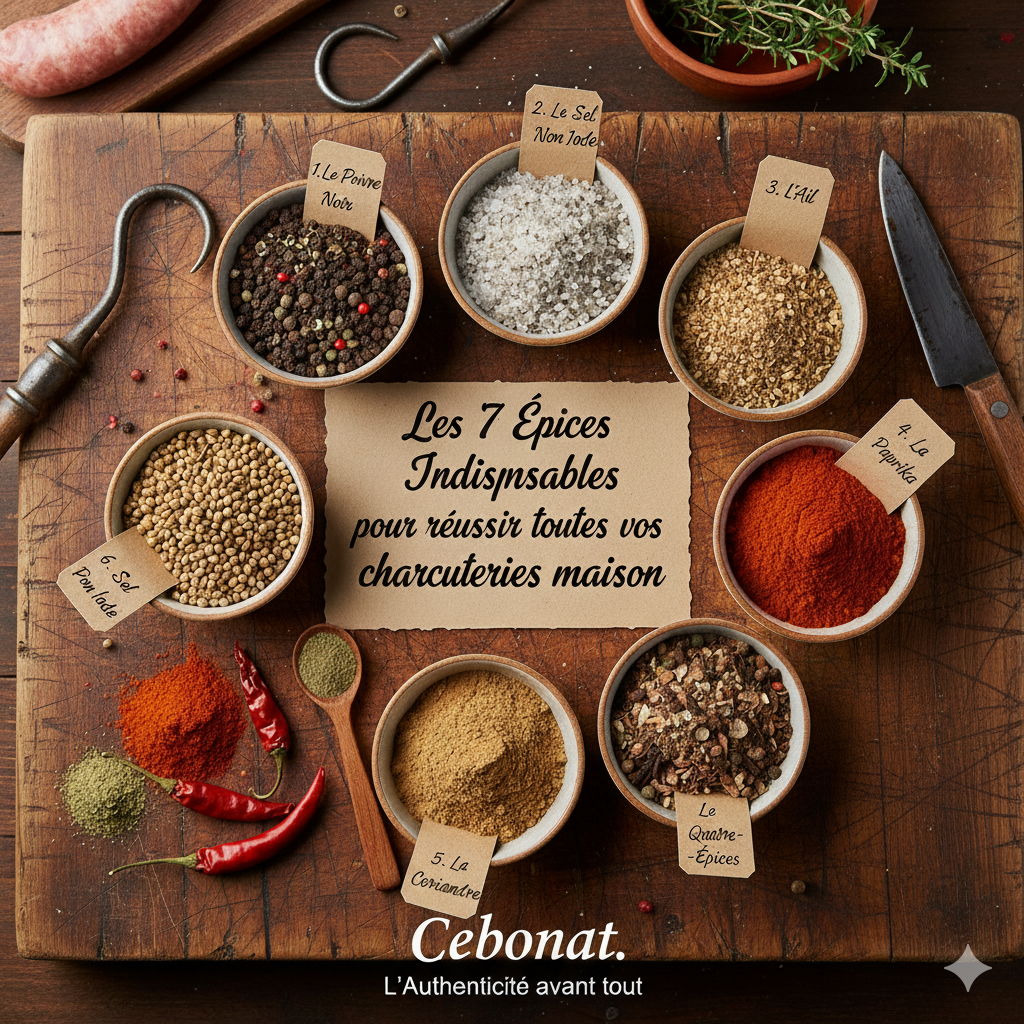The 7 Essential Spices for Perfect Homemade Charcuterie

Here are the 7 essential spices that should be in the arsenal of every amateur or professional homemade charcuterie enthusiast.
1. Black Pepper: The Unmissable King
Black pepper is undoubtedly the most universal spice in charcuterie. Whether ground, cracked, or in whole peppercorns, it provides that pungent, aromatic note that awakens any preparation. Its power varies depending on the grind: finely ground, it quickly diffuses its aromas throughout the stuffing; coarsely cracked, it offers bursts of flavor in every bite.
Black pepper integrates perfectly into saucisses de Toulouse (Toulouse sausages), pâtés de campagne (country pâtés), terrines, and even saucissons secs (dry-cured sausages). For optimal quality, favor freshly ground pepper that retains its full aromatic power.
2. Non-Iodized Salt: More Than Just Seasoning
In charcuterie, salt plays a crucial dual role: it seasons while also contributing to the preservation and texture of your preparations. However, not all salts are equal. Iodized salt, commonly used in cooking, can alter the delicate taste of certain charcuterie products and interfere with the maturation process of dry-cured sausages.
Therefore, non-iodized salt is the absolute standard for all your charcuterie creations. It preserves the authenticity of the flavors without introducing an undesirable bitterness. Whether you are salting a stuffing, preparing a brine, or preserving your natural casings, non-iodized salt remains your best ally.
3. Garlic: Fresh, Powder, or Granulated?
Garlic is an emblematic spice in French and Mediterranean charcuterie. Saucisson à l'ail (garlic sausage), merguez, chorizo, pâtés... few preparations do not benefit from its pronounced and comforting character.
The question often arises: fresh garlic or garlic powder? In charcuterie, extra-fine granulated garlic offers the best compromise. Finer than dehydrated pieces of garlic, it disperses evenly throughout the stuffing and is less likely to burn during cooking. Fresh garlic, while flavorful, can develop bitterness during drying or prolonged cooking. Reserve it instead for fresh preparations consumed quickly.
4. Paprika: Color and Sweetness
Paprika is a versatile spice that brings both color and flavor to your charcuterie. Sweet or slightly hot, it enhances sausages, blood sausages (boudins), and especially chorizo, in which it is the star ingredient.
Paprika has the unique ability to naturally color your preparations without aggressively altering their taste. It provides a roundness on the palate and a slightly sweet note that balances the other, more potent spices. For an authentic chorizo, smoked paprika is even essential.
5. Coriander: Subtle and Unexpected Freshness
Often associated with Asian or Mediterranean cuisine, coriander seeds nonetheless have a place of choice in traditional charcuterie. Cracked or ground, they release citrusy and slightly sweet aromas that add complexity without overpowering.
Coriander pairs particularly well with pork and lamb, making it a key ingredient for merguez, Oriental-style sausages, and certain game pâtés. Its unique aromatic profile helps avoid monotony in your creations and pleasantly surprises seasoned palates.
6. Allspice (Quatre-Épices): The Secret to Successful Pâtés
Allspice, also known as quatre-épices (four-spices) in French, is the mystery ingredient in many traditional pâtés and terrines. True to its name, it single-handedly evokes the flavors of cinnamon, clove, nutmeg, and ginger.
This warm and comforting spice is particularly appreciated in pâtés de campagne, game terrines, and poultry preparations. Used sparingly, allspice provides an incomparable aromatic depth and that "homemade" touch that makes all the difference.
7. Chili Powder/Flakes (Piment): Accurately Dosing the Heat
Chili (whether mild or extra-hot) allows you to customize the intensity of your charcuterie according to your taste and that of your guests. A key ingredient in merguez, chorizo, and many Southern-style sausages, it provides that touch of character that awakens the taste buds.
The art of using chili in charcuterie lies in the dosage. Too much will mask the other flavors; properly mastered, it enhances the entire preparation by creating a progressive and pleasant heat. Always start with small quantities that you can adjust in your next batches.
Getting Started Right with Cebonat Blends
If you're a beginner in homemade charcuterie, these seven spices form your essential starter kit. However, we understand that measuring and balancing these ingredients can seem complex at first.
This is why Cebonat has developed a complete range of professional spice blends, specially formulated for each type of charcuterie: dry-cured sausage, chorizo, merguez, country pâté, game terrine, etc. Our blends incorporate these essential spices in perfectly balanced proportions, guaranteeing you a successful result every time.
Once you're comfortable with our blends, you can gradually customize them by adding a touch of cracked pepper, a hint of extra garlic, or a pinch of chili according to your creative desires.
Authenticity Above All Else
At Cebonat, we prioritize natural spices, free of artificial additives or unnecessary preservatives. Each spice is selected for its freshness and aromatic power, ensuring your homemade charcuterie has an authentic taste and distinct flavors.
Combined with our premium natural casings, these seven essential spices will allow you to create sausages, pâtés, and cured sausages that rival the best artisan charcutiers. Ready to get started? Begin with this solid foundation, and let your creativity express itself through your experiments!




